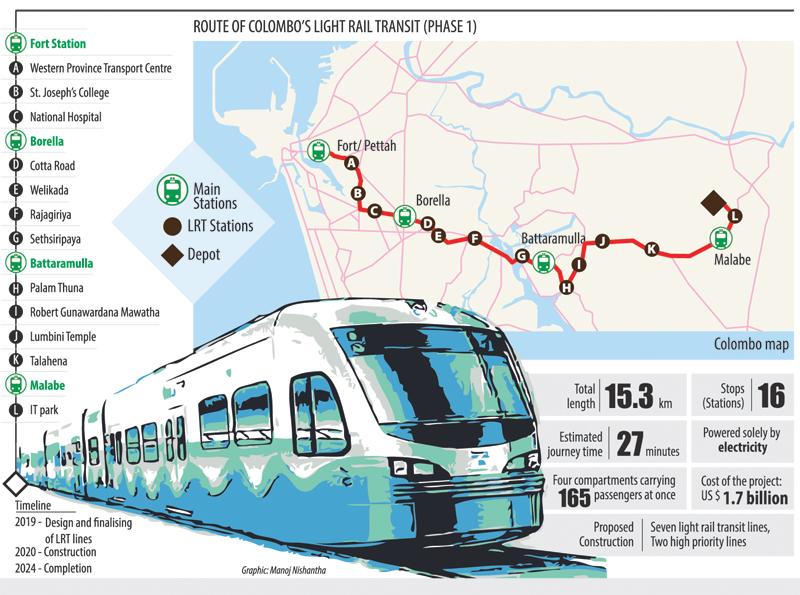
The Ministry of Megapolis and Western Development on Friday announced the commencement of acquisition of lands required for the construction of the proposed fully elevated Light Rail Transit (LRT) system in Colombo which is set to revolutionise Sri Lanka’s transportation system.
The move follows the official handing over of the feasibility studies of the project carried out by Seoyoung Engineering to the Minister of Megapolis and Western Development, Patali Champika Ranawaka by the Country Director of Japan International Co-operation Agency, Fusato Tanaka. Simultaneously, the official website of the Light Railway Project (www.clr.lk) was also launched on Friday by the Minister and JICA Sri Lanka officials.
According to Ministry officials, the Japan International Cooperation Agency (JICA), the governmental agency that coordinates official development assistance for the government of Japan, is expected to provide a US$ 1.7 billion equivalent yen denominated loan at 0.1 percent interest for the project. The loan will have 40-year repayment term with 12 year grace period.
“The financing agreement for Phase I of the project is expected to be wrapped up by the end of this year with contracts for detailed designs due to be awarded shortly afterwards. Construction work of the first phase of the project will commence in 2020 while commercial operations are projected to kick off by 2024,” Ministry officials who spoke to The Sunday Observer noted.
The project’s construction is divided into seven phases, with phase 1 encompassing the construction of part of RTS 1 (Fort to Union Place) and RTS 5 (Battaramulla to Malabe), along with the entirety of RTS 4 (scheduled to begin in late 2018/early 2019), and phases 2 through 7 expanding the network throughout the planned Western Region Megapolis.
Under the first phase of the project, the 25 kilometer LRT system comprises 16 stations and a depot that will run from Malabe IT Park to Pettah. The LRT will connect some of the highly commercialised areas including Borella, Rajagiriya and Battaramulla and will have a station at Townhall, close to the the heart of healthcare for Sri Lankans, the Colombo General Hospital.
Compartments
The proposed LRT powered solely by electricity and comprising of seven light rail transit lines and two high priority lines will have four compartments enabling the carriage of 165 passengers at once. The total cost of the project for the seven phases is estimated at around US $ 6 billion.
“The government is not implementing projects that will push the country into further debt but only those that will steer the path towards development.
This project will be a novel breakthrough in the transport sector after 1860, the year in which railways was first introduced to Sri Lanka,” Minister Ranawaka noted.
He revealed of plans to establish three more similar LRT systems parallel to this project in the form of a public-private partnership (PPP) where they will begin within the first half of next year.
“For a project to be successful, a proper feasibility analysis, environmental analysis, societal analysis and, especially, a financial analysis are crucial. Due to improper financial comprehension and analysis of projects we did in the past, the country got caught in a debt trap,” Ranawaka asserted.
The Minister noted that the US$ 1.7 billion light rail project, one of the key public transport improvements identified in the Megapolis Transport Masterplan will ease congestion, speed up travel time from Malabe to Colombo to 30 minutes from the current 45 to 90 minutes.
“Massive initiative of transportation under Megapolis is the introduction of this LRT system.It spreads across Colombo and suburbs as a network to cater to the projected demand induced by the proposed Megapolis structure plan by improving the interconnectivity between different modes of transportation such as buses, ferry transportation and suburban railway,” Ranawaka outlined.
He highlighted that the first step taken towards the introduction of LRT to Sri Lanka with the financial and technical assistance of Japan International Corporation Agency (JICA) under Special Terms for Economic Partnership (STEP) will regenerate the urban context of Colombo.
According to the Minister, as the severe problem of traffic within and around Colombo city will result in a negative impact to the economic performance of the country, it is vital to solve the problem of congestion through which people will be benefited with saved time, fuel and low carbon foot print.
“Towards this end, the proposed LRT system enhances the economic development, environmental sustainability and inter-modality which support socio, cultural, economic and wellbeing of all citizens,” Minister Ranawaka emphasised.
Meanwhile, Project Director-Colombo Light Rail Transit Project of the Ministry of Megapolis and Western Development, Eng. Commander (Rtd) Chaminda Ariyadasa said the LRT-JICA project is focused on improving the lives of commuters passing through the Malabe and Fort corridor facilitating minimum traffic congestion, reduced travel time, low passage cost, improved air quality, safe travel and economic development.
“The project will provide connectivity between Malabe and Colombo Fort, which is one of the busiest traffic corridors in the Colombo Metropolitan area,” Ariyadasa said.
Pointing to some statistics, Secretary to the Ministry of Megapolis and Western Development, Eng. Nihal Rupasinghe said that nearly one million people enter the city of Colombo on a day to day basis thus causing severe traffic congestion in and around Colombo.
Therefore, based on current saturated traffic condition at major roads in Colombo city, he said it is crucial to improve public transportation and increase the percentage of public transport commuters.
“It is expected that this proposed LRT system will cater the planned growth induced by the MegapolisStructure Plan for the coming decades. While improving mobility, this system will enhance the convenience of the public creating a positive perception towards using public transportation in Sri Lanka,” Rupasinghe added.
